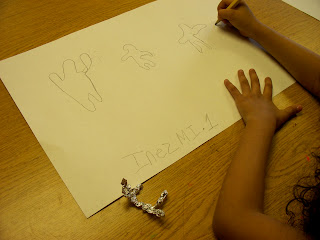1st Graders learned in art class about how their bodies move, with the joints that bend us and allow us to redirect ourselves in a myriad of ways. We looked at art work by Edgar Degas (his ballerinas), Keith Harrings' wonderful street art of simplified figures moving and dancing, and African American Folk artist Jacob Lawrence, who did many paintings depicting the expression and emotion of the human body. I asked the students what they noticed about the way the people in the paintings were positioned, and how it made them feel to look them. What did they think the people in the paintings were feeling? They said, "Excited!", "Happy!", and one student said,"Tired" when they looked at Degas ballerinas. I imagine those ballerinas were tired. I asked them if they thought the artists asked the people they painted to lay down on a canvas so they could trace them. They all knew that an artist wouldn't do that. Because an artist that paints people and animals needs to understand the way our bodies move, how our joints bend, and what positions we can get into and which ones we can't. We talked about the fact that our elbows and knees can only bend one way, and we all got out of our seats to try to bend our limbs as many ways as we could! We found that we could bend backwards and forwards, from side to side, our head, feet and hands could bend the same.
So, after we made some funny looking poses, I showed the students how they could make a foil figure that they could bend like a real person. This was a trick I learned at a summer art conference at the museum. First, take a piece of foil (about 4" x 6") and make two tears, about 2" long, evenly space apart at the top of the piece as it stands vertically long. Then make one tear up the center, about 2", so that there is foil in the center that is not torn (this will be the torso). Next, scrunch up (I know, this is highly technical terminology) the foil at the top into three sections, being careful to keep their length (in other words, don't fold it over or ball it up). The center piece of foil will be the head (this can be balled up slightly to make it look like a head shape). The two bottom pieces are scrunched up next to make the legs, then finally, the center is scrunched together to make the torso. I told the students that they couldn't trace their foil figures-remember, a REAL artist would NEVER do that! I demonstrated how they could bend it in as many ways as they wanted (being careful not to bend it unrealistically), and look at their figure, studying the lines that it made in order to make a contour drawing of it. And by George, they got it! I couldn't believe my own eyes! 1st graders making wonderful contour drawings of the body in motion! They made them standing on their heads, doing back flips, the splits, jumping in the air- they told me what their figures were feeling- "Mrs. Gallow, my person is so happy because they got an A on their schoolwork!" They absolutely LOVED their foil people and wanted to take them home. This was a two part project, so we needed to keep them to help us with completing our art the second class. I paper clipped them to their work as I put it up. But, I told them, ask your mom or dad for a piece of foil from the kitchen and show them what you can do. Make one at home and practice your drawings of people moving. They will be amazed! The second art class they could take them home.
Finally, after their contour drawings were done in pencil, I had the students trace them with a sharpie and color them in with colored markers. I encouraged them to make more concentric lines going around their contour figures and to get creative with what types of lines and designs they could add to their artwork. The drawings are electric with energy and so much fun! I think that my art students, in first grade, are well on their way to understanding how to draw a person in motion... I can only imagine what their going to be able to do by 5th grade!











No comments:
Post a Comment